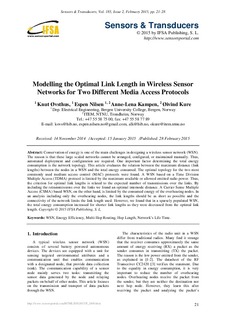| dc.contributor.author | Øvsthus, Knut | |
| dc.contributor.author | Nilsen, Espen | |
| dc.contributor.author | Kampen, Anne-Lena | |
| dc.contributor.author | Kure, Øivind | |
| dc.date.accessioned | 2017-05-31T13:16:10Z | |
| dc.date.available | 2017-05-31T13:16:10Z | |
| dc.date.created | 2015-03-05T15:44:08Z | |
| dc.date.issued | 2015 | |
| dc.identifier.citation | Sensors & Transducers Journal. 2015, 185 (2), 21-28. | nb_NO |
| dc.identifier.issn | 1726-5479 | |
| dc.identifier.uri | http://hdl.handle.net/11250/2444011 | |
| dc.description.abstract | Conservation of energy is one of the main challenges in designing a wireless sensor network (WSN). The reason is that these large scaled networks cannot be arranged, configured, or maintained manually. Thus, automated deployment and configuration are required. One important factor determining the total energy consumption is the network topology. This article evaluates the relation between the maximum distance (link lengths) between the nodes in a WSN and the total energy consumed. The optimal topology for the two most commonly used medium access control (MAC) protocols were found. A WSN based on a Time Division Multiple Access (TDMA) protocol is limited by the maximum available or allowed emitted radio power. Thus, the criterion for optimal link lengths is related to the expected number of transmissions over the links. By including the retransmissions over the links we found an optimal internode distance. A Carrier Sense Multiple Access (CSMA) based WSN, on the other hand, is limited by the consumed energy of the overhearing nodes. In an analysis including only the overhearing nodes, the link lengths should be as short as possible and the connectivity of the network limits the link length used. However, we found that in a sparsely populated WSN, the total energy consumption increased for shorter link lengths as they were decreased from the optimal link length. | nb_NO |
| dc.language.iso | eng | nb_NO |
| dc.publisher | International Frequency Sensor Association (IFSA) | |
| dc.relation.uri | http://www.sensorsportal.com/HTML/DIGEST/february_2015/Vol_185/P_2600.pdf | |
| dc.subject | WSN, Energy Efficiency, Multi-Hop Routing, Hop Length, Network’s Life Time. | nb_NO |
| dc.title | Modelling the Optimal Link Length in Wireless Sensor Networks for Two Different Media Access Protocols | nb_NO |
| dc.type | Journal article | nb_NO |
| dc.type | Peer reviewed | nb_NO |
| dc.description.version | publishedVersion | nb_NO |
| dc.source.pagenumber | 21-28 | nb_NO |
| dc.source.volume | 185 | nb_NO |
| dc.source.journal | Sensors & Transducers Journal | nb_NO |
| dc.source.issue | 2 | nb_NO |
| dc.identifier.cristin | 1229777 | |
| dc.description.localcode | Open access license: CC-BY-NC | nb_NO |
| cristin.unitcode | 194,63,30,0 | |
| cristin.unitname | Institutt for telematikk | |
| cristin.ispublished | true | |
| cristin.fulltext | original | |
| cristin.qualitycode | 1 | |
